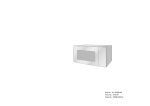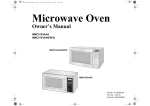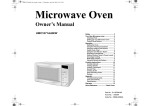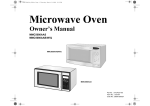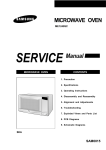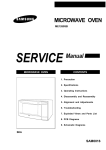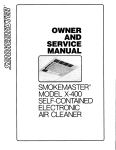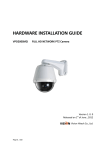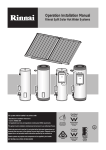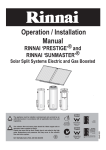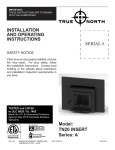Download Maytag AMC5143AAB Service manual
Transcript
Service This manual is to be used by qualified appliance technicians only. Maytag does not assume any responsibility for property damage or personal injury for improper service procedures done by an unqualified person. 2004 Countertop Domestic Microwaves This Base Manual covers general information Refer to individual Technical Sheet for information on specific models This manual includes, but is not limited to the following: UMC1071AAB/W AMC4080AAB/W/Q/S MMC5080AAB/W/Q/S AMC5101AAB/W/Q/S AMC5143AAB/W/Q/S MMC5193AAB/W/Q/S 16022923 Revision 0 April 2004 Important Information Pride and workmanship go into every product to provide our customers with quality products. It is possible, however, that during its lifetime a product may require service. Products should be serviced only by a qualified service technician who is familiar with the safety procedures required in the repair and who is equipped with the proper tools, parts, testing instruments and the appropriate service manual. REVIEW ALL SERVICE INFORMATION IN THE APPROPRIATE SERVICE MANUAL BEFORE BEGINNING REPAIRS. Important Notices for Consumers and Servicers ! WARNING To avoid risk of serious injury or death, repairs should not be attempted by an unauthorized service personnel, dangerous conditions (such as exposure to electrical shock) may result. ! CAUTION Maytag will not be responsible for any injury or property damage from improper service procedures. If performing service on your own product, assume responsibility for any personal injury or property damage which may result. To locate an authorized servicer, please consult your telephone book or the dealer from whom you purchased this product. For further assistance, please contact: Customer Service Support Center CAIR Center Web Site Telephone Number WWW.AMANA.COM ................................................ 1-800-843-0304 WWW.MAYTAG.COM ............................................. 1-800-688-9900 CAIR Center in Canada ........................................... 1-800-688-2002 Amana Canada Product ........................................... 1-866-587-2002 Recognize Safety Symbols, Words, and Labels ! DANGER DANGER—Immediate hazards which WILL result in severe personal injury or death. ! WARNING WARNING—Hazards or unsafe practices which COULD result in severe personal injury or death. ! CAUTION CAUTION—Hazards or unsafe practices which COULD result in minor personal injury or product or property damage. 2 16022923 Rev. 0 ©2004 Maytag Services Table of Contents Important Information .................................................... 2 Important Safety Information ......................................... 4 Microwave Leakage Testing .......................................... 5 General Information Specifications ............................................................ 7 Placement of the Oven ............................................... 7 Location of Model Number ......................................... 7 Model Identification .................................................... 7 Service ....................................................................... 7 Parts and Accessories ............................................... 7 Asure™ Extended Service Plan ................................. 7 Radio Interference ...................................................... 7 Electrical Requirements ............................................. 8 Cleaning ..................................................................... 8 Grounding Instructions ............................................... 8 Microwave Oven Description ...................................... 9 Troubleshooting Procedures General ........................................................................ 10 Error Codes Model MMC5080AA* ............................................. 12 Models AMC5143AA* and MMC5193AA* .............. 12 Testing Procedures ............................................... 13 - 16 ©2004 Maytag Services Disassembly Procedures Door Assembly ......................................................... 19 Door Disassembly .................................................... 19 Outer Case ............................................................... 20 Control Panel ............................................................ 20 P.C. Board ................................................................ 20 Control Key Panel ..................................................... 21 Interlock Door Latch Switches .................................. 21 High Voltage Capacitor ............................................. 22 Diode ........................................................................ 22 Transformer .............................................................. 22 Fuse ......................................................................... 23 Magnetron ................................................................ 23 Suction Guide/Fan Motor Assembly ......................... 23 Humidity Sensor-MMC5080AA*, AMC5143AA*, MMC5193AA* ....................................................... 24 Oven Thermostat ...................................................... 24 Light Socket ............................................................. 24 Turntable Motor ......................................................... 24 Appendix A Installation Instructions for AMC5143AA* ...................................................... A-2 Installation Instructions for AMC4080AA* and MMC5080AA* ........................ A-6 Appendix B Programming Instructions for AMC4080AA* ...................................................... B-2 Programming Instructions for MMC5080AA* ..................................................... B-4 Programming Instructions for AMC5101AA* ...................................................... B-6 Programming Instructions for AMC5143AA* .................................................... B-10 Programming Instructions for MMC5193AA* ................................................... B-15 Care and Cleaning ................................................ B-20 16022923 Rev. 0 3 3 Important Safety Information ! CAUTION Read the following information to avoid possible exposure to microwave radiation: The basic design of the Maytag and Amana microwave oven makes it an inherently safe device to both use and service. However, there are some precautions which should be followed when servicing the microwave oven to maintain this safety. These are as follows: 1. Always operate the unit from an adequately grounded outlet. Do not operate on a two-wire extension cord. 2. Before servicing the unit (if unit is operable), perform the microwave leakage test. 3. The oven should never be operated if the door does not fit properly against the seal, the hinges or hinge bearings are damaged or broken; the choke is damaged, (pieces missing, etc.); or any other visible damage can be noted. Check the choke area to ensure that this area is clean and free of all foreign matter. 4. If the oven operates with the door open and produces microwave energy, take the following steps. A. Tell the user not to operate the oven. B. Contact Maytag immediately. 5. Always have the oven disconnected when the outer case is removed except when making the "live" tests called for in the Service Manual. Do not reach into the equipment area while the unit is energized. Make all connections for the test and check them for tightness before plugging the cord into the outlet. 6. Always ground the capacitors on the magnetron filter box and H. V. Capacitor with an insulated-handle screwdriver before working in the high voltage area of the equipment compartment. Some types of failures will leave a charge in these capacitors and the discharge could cause a reflex action which could make you injure yourself. 4 7. In the area of the transformer, capacitor, diode, and magnetron there is HIGH VOLTAGE. When the unit is operating, keep this area clean and free of anything which could possibly cause an arc or ground, etc. 8. Do not for any reason defeat the interlock switches. There is no valid reason for this action at any time; nor will it be condoned by Maytag. 9. IMPORTANT: Before returning a microwave to a customer, check for proper switch interlock action. The primary and secondary switches MUST open when the door is actuated. The monitor switch MUST close at a 1/4 inch when the door is opened. 10.Before returning a microwave to a customer, verify the door spacing is reasonably uniform along the top, bottom, and sides, and that it measures 1/8 inch or less. 11. The microwave oven should never be operated with: • Any components removed and/or bypassed. • Any of the safety interlocks failing. • Any of the seal surfaces failing, missing, or damaged. 12.To ensure that the unit does not emit excessive microwave leakage and to meet the Department of Health Human Service guidelines, check the oven for microwave leakage using Narda Model 8100, 8200, Holaday HI1500, HI1501 or Simpson 380M leakage monitor as outlined in the instructions. The maximum leakage level allowed is 4mW/cm2. 13. If servicer encounters an emission reading over 4 mW/cm2 the servicer is to cease repair and contact the Maytag Service Department immediately for further direction. Maytag will contact the proper Government Agency upon verification of the test results. 16022923 Rev. 0 ©2004 Maytag Services Microwave Leakage Testing ! Measurement With the Outer Panel Removed W ARNING Check for radiation leakage after servicing. Should the leakage be more than 4mW/cm2 inform Maytag immediately. After repairing or replacing any radiation safety device, keep a written record for future reference, as required by D.H.H.S. and HEW regulations. This requirement must be strictly observed. In addition, the leakage reading must be recorded on the service repair ticket while in the customer’s home. Avoid contacting any high voltage components. Whenever you replace the magnetron, measure for radiation leakage before the outer panel is installed and after all necessary components are replaced or adjusted. Special care should be taken in measuring around the magnetron. Equipment Measurement With a Fully Assembled Oven • Electromagnetic radiation monitor • 600 cc glass beaker After all components including the outer panel are fully assembled, measure for radiation leakage around the door periphery, the door viewing window, the exhaust opening, and air inlet openings. Procedure For Measuring Radiation Leakage Note before measuring • Do not exceed meter full scale deflection. Leak monitor should initially be set to the highest scale. • To prevent false readings the test probe should be held by the grip portion of the handle only. • The scan speed is equal to one inch per antenna revolution or one inch per second if antenna speed is unknown. • Areas to be checked are all door seal areas and any venting parts. • Leakage with the outer panel removed...4mW/cm2 or less. • Leakage for fully assembled oven with door normally closed ...4mW/cm2 or less. • Leakage for a fully assembed oven (before the latch switch (primary) is interrupted) while pulling the door ... 4mW/cm2 or less. 1 . Pour 275 ±15 cc (9 oz ±1/2 oz) of 20 ± 5°C (68 ± 9°F) water in a beaker which is graduated to 600 cc and place the beaker in the center of oven. 2. Set the radiation monitor to 2450 MHz and use it following the manufacturer’s recommended test procedure to assure correct results. 3. While measuring the leakage, always use the two inch (5 cm) spacer supplied with the probe. 4. Press the start pad or turn on the timer and with the magnetron oscillating, measure the leakage by holding the probe perpendicular to the surface being measured. ©2004 Maytag Services Record Keeping and Notification After Measurement 1. After any adjustment or repair to a microwave oven, a leakage reading must be taken. Record this leakage reading on the repair ticket even if it is zero. 2. A copy of the repair ticket and the microwave leakage reading should be kept by the repair facility. 16022923 Rev. 0 5 General Information This manual provides basic instructions and suggestions for handling, installing , and servicing microwave ovens. The directions, information, and warnings in this manual are developed from experience with, and careful testing of the product. If the unit is installed according to the Installation Instructions, it will operate properly and will require minimal servicing. A unit in proper operating order ensures the consumer all the benefits provided by efficient microwave cooking. This manual contains information needed by authorized service technicians to install and service the microwave pertaining to this manual. There maybe, however some information which needs further explanation. Refer to individual Installation Instructions, Use and Care, Technical Sheets, or toll free technical support line to answer questions from authorized service technicians. Cooking Nomenclature A M C 5 5 1 5 A A W Color A B C H L P Q S T W F N Brand A C G H J M N U Y Amana Magic Chief Graffer & Sattler Hardwick Jenn-Air Maytag Norge Universal Crosley Listing Fuel B D E/J G L M P X W Almond on Almond Black Brushed Chrome Traditional White Traditional Almond Prostyle Monochromatic Bisque Stainless Traditional Bisque White on White Frost White (True Color White) Natural Bisque (True Color Bisque) A C D G M P Butane Dual Fuel Electric Gas, Natural Liquid Propane Microwave Standing Pilot No Fuel Warming Drawer X UL/AGA CSA/CGA/CUL Dual Listed 220-240 V / 50-60 Hz Military Model PSB Approved (Singapore) Export 120 V / 60 Hz Production Code This identifies which version of production the unit is. Product Type A C D E G L M P Q R S T V W Y Z 6 Accessory/Cartridge Cooktop Updraft/Countertop Downdraft Cooktop or Warming Drawer Eyelevel Range Grill Range (20") Range (36") Drop In (24") Wall Oven (27") Range, Free-Standing (30") Slide-In (30") Range Hood OTR Wall Oven RV Range RV Top Feature Content 1000-3999 4000-6999 7000-9999 16022923 Rev. 0 Brands Maytag/Amana ©2004 Maytag Services General Information Specifications Refer to individual Technical Sheet for specification information. Placement of the Oven This microwave can be easily placed in the kitchen, family room, or anywhere else in the house. Place the oven on a flat surface such as a kitchen countertop or a specially designed microwave oven cart. Do not place oven above a gas or electric range. Free air flow around the oven is important. Do Not Block Air Vents All air vents must be kept clear during cooking. If air vents are covered during operation the oven may overheat. In this case, a sensitive thermal safety device automatically turns the oven off. The oven will be inoperable until the oven has cooled sufficiently. Location of Model Number To request service information or replacement parts, the service center will require the complete model, serial, and manufacturing number of your microwave oven. The number is located on the oven front as shown in the illustration below. Service Keep a copy of sales receipt for future reference or in case warranty service is required. To locate an authorized servicer: • For Amana product call 1-800-628-5782 or visit the Web Site at www.amana.com • For Maytag product call 1-800-462-9824 or visit the Web Site at www.maytag.com • For product in Canada call 1-866-587-2002 or visit the Web Sites at www.amana.com or www.maytag.com Warranty service must be performed by an authorized servicer. We also recommend contacting an authorized servicer, if service is required after warranty expires. Parts and Accessories Purchase replacement parts and accessories over the phone. To order accessories for your product call: • For Amana product call 1-877-232-6771 or visit the Web Site at www.amana.com • For Maytag product call 1-800-462-9824 or visit the Web Site at www.maytag.com • For product in Canada call 1-866-587-2002 or visit the Web Sites at www.amana.com or www.maytag.com Extended Service Plan Cavity Front We offer long-term service protection for this new oven. • Asure™ Extended Service Plan is specially designed to supplement Amana’s strong warranty. This plan covers parts, labor, and travel charges. Call 1-866-232-6244 for information. • Dependability PlusSM Extended Service Plan is specially designed to supplement Maytag’s warranty. This plan covers parts, labor, and travel charges. Call 1-800-925-2020 for information. Model Identification Complete enclosed registration card and promptly return. If registration card is missing: • For Amana product call 1-800-843-0304 or visit the Web Site at www.amana.com • For Maytag product call 1-800-688-9900 or visit the Web Site at www.maytag.com • For product in Canada call 1-866-587-2002 or visit the Web Sites at www.amana.com or www.maytag.com When contacting provide product information located on rating plate. Record the following: Model Number: ___________________ Manufacturing Number: ___________________ Serial or S/N Number: ___________________ Date of purchase: ___________________ Dealer’s name and address: ___________________ ©2004 Maytag Services Radio Interference 1. Microwave oven operation may interfere with the radio or TV reception. 2. When there is interference, it may be reduced or eliminated by taking the following measures: • Clean the door and the seal surface of the oven. • Reorient the receiving antenna of the radio or TV. • Relocate the microwave oven in relation to the radio or TV. • Move the microwave away from the receiver. • Plug the microwave into a different outlet so that the microwave and receiver are on different branch circuits. 3. 120 VAC, 60 Hz household outlet. Be sure the circuit is at least 15 or 20 A and the microwave oven is the only appliance on the circuit. It is not designed for 50 Hz or any circuit other than a 120 VAC, 60 Hz circuit. • Electrical Rating of the Oven: 120 VAC, 60 Hz 16022923 Rev. 0 7 General Information Electrical Requirements Grounding Instructions The oven is designed to operate on a Standard 120 VAC, 60 HZ household outlet. This appliance must be grounded. If an electrical short circuit occurs, grounding reduces the risk of electric shock by providing an escape wire for the electric current. The cord for this appliance has a grounding wire with a grounding plug. Put the plug into an outlet that is properly installed and grounded. Cleaning Before cleaning the oven, unplug the power supply cord. If impossible, open the oven door to prevent an accidental oven start. Inside of the Oven Use a damp cloth to wipe out crumbs and spillovers. It is important to keep the area between door and cavity front clean to assure a tight seal. Remove greasy spatters with a sudsy cloth, then rinse and dry. Do not use harsh detergent or abrasive cleaners. Glass Tray The glass tray can be washed by hand or in the dishwasher. ! Ask a qualified electrician if you do not understand the grounding instructions or if you wonder whether the appliance is properly grounded. Keep the electrical power cord dry and do not pinch or crush it in any way. Control Panel Wipe with a damp cloth followed immediately by a dry cloth. The Child Lock feature is also useful when cleaning the control panel. Child Lock prevents accidental programming when wiping the control panel (if so equipped). Properly Polarized and Grounded Outlet Door If steam accumulates inside or around the outside of the oven door, wipe the panel with a soft cloth. This may occur when the microwave oven is operated under high humidity conditions and in no way indicates a malfunction of the unit. Outside Oven Surface Clean with damp cloth. To prevent damage to the operating parts inside the oven, the water should not be allowed to seep into the ventilation openings. After cleaning the oven, be sure that the rotating ring and the glass tray are in the right position. Press the STOP/ CLEAR pad twice to reset any accidental key setting. 8 W AR NIN G To avoid risk of electric shock, personal injury or death, use grounding plug properly. Three-Pronged (Grounding) Plug For a permanently connected appliance: This appliance must be connected to a grounded, metallic, permanent wiring system, or an equipment grounding conductor should be run with the circuit conductors and connected to the equipment grounding terminal or lead on the appliance. 16022923 Rev. 0 ©2004 Maytag Services General Information Microwave Oven Description Door Light Ventilation Holes Safety Interlock Holes Control Panel Door Latches CE1D33 Open Door PushButton Glass Tray ©2004 Maytag Services Guide Roller 16022923 Rev. 0 9 Troubleshooting Procedures ! WARNING To avoid risk of electrical shock, personal injury or death; disconnect power to oven and discharge the high voltage capacitor before servicing, unless testing requires power. ! CAUTION • • • • • Verify proper grounding before checking for trouble. Be careful of the high voltage circuit. Discharge the high voltage capacitor. When checking the continuity of the switches or of the high voltage transformer, disconnect one lead wire from these parts and then check continuity with the AC plug removed. To do otherwise may result in a false reading or damage to your meter. Do not touch any part of the circuit on the printed circuit board, since static electric discharge may damage the control panel. Always touch yourself to ground while working on this panel to discharge any static charge built up in your body. Problem No display and no operation (fuse tests OK) Possible Cause Open or loose lead wire harness.................... Open thermal cutout (magnetron) Open low voltage transformer Defective Assembly PCB ............................... No display and no operation (fuse blown) Shorted lead wire harness.............................. Defective primary switch Defective monitor switch Shorted high voltage capacitor....................... Shorted high voltage transformer Cannot program oven Key input is not in-sequence .......................... Open or loose membrane key pad to Assembly PCB connection ............................. Membrane panel shorted or open Defective Assembly PCB ............................... 10 16022923 Rev. 0 Correction • Check wire harness, thermal cutout and low voltage transformer for loose wires and continuity, tighten wires where necessary or replace failed component, if necessary. If thermal cutout is replaced, check fan motor. Replace if necessary. • Check Assembly PCB. Also, if low voltage transformer is defective, check/replace PCB. • Check adjustment of primary switch, monitor switch, power relay, door sensing switch. Readjust/replace if necessary. The primary, secondary and monitor switch must be replaced at the same time. • Check measurement of high voltage capacitor and high voltage transformer. Replace if necessary. If high voltage transformer is replaced, check magnetron and diode. • See Operation Procedure and verify program sequence • Check connections of membrane keypad to Assembly PCB, tighten/reconnect where necessary. • Replace Assembly PCB ©2004 Maytag Services Troubleshooting Procedures Problem Timer begins countdown but microwave does not oscillate (oven lamp illuminates, fan motor engages but oven does not produce heat) Oven lamp illuminates and fan motor engages Timer does not start once oven is programmed Microwave output is low; oven takes longer time to cook food Fan motor engages when oven is connected to electrical source Oven does not operate and return to standby Oven emits loud noises when operating Turntable motor does not engage Oven ceases operation during cooking process Sparks emitting during cooking process Uneven cooking Noise emitting from turntable motor during operation ©2004 Maytag Services Possible Cause Latch switches not aligned properly ................ Open or loose high voltage circuit connection, including magnetron filament circuit (greater contact resistance lowers magnetron filament voltage, resulting in lower magnetron output and/or intermittent oscillation) ......................... Defective high voltage components (transformer, capacitor, diode, fuse, magnetron) ...................................................... Open or loose power relay wiring Defective primary latch switch Defective power relay or Assembly PCB ........ Maladjustment or loose wiring of primary latch switch Defective primary latch switch Open or loose wiring of secondary interlock switch Off-alignment of primary interlock Defective secondary interlock switch Decrease in power source voltage.............. Open or loose magnetron filament circuit (intermittent oscillation) Aged magnetron Loose wiring on door sensing switch .......... Correction • Adjust door and latch switches, replace if necessary • Check high voltage circuit connections. Tighten/reconnect where necessary • Check measurements on high voltage components. See test procedure in Replace component/s if necessary • Replace Assembly PCB • Check wiring connections and adjust door and latch switches. Replace if necessary. • Check wiring connections and adjust door and interlock switches. Replace if necessary. • Consult electrician. • Check door sensing switch wire. Defective Assembly PCB ............................ • Replace Assembly PCB Loose fan/fan motor .................................... Loose screws on high voltage transformer . • Tighten screws of fan/fan motor. • Tighten screws of high voltage transformer. • Replace high voltage diode. • Check and replace turntable motor, if necessary. • Adjust door and latch switches. Shorted high voltage diode ......................... Open or loose turntable motor wiring .......... Defective turntable motor Open or loose wiring of primary interlock switch Metallic ware or cooking dishes touching the oven wall ..................................................... Ceramic ware trimmed with gold or silver powder Microware intensity characteristics Motor 16022923 Rev. 0 • Remove all cookware trimmed with metallic substances • Wrap thinner parts of food with aluminum foil, plastic wrap or cover with a lid. • Stir once or twice while cooking foods such as soup, cocoa or milk. • Replace turntable motor. 11 Troubleshooting Procedures Sensor Error Codes (Model MMC5080AA*) Error Code Possible Cause Error 1 Shorted circuit. Error 2 Error 3 Error 4 Open circuit. During cooling, sensor output was not less then 4.7V within 3 minutes. Door open when attempting to operate sensor program. Sensor Error Codes (Models AMC5143AA* and MMC5193AA*) Error Code Possible Cause E1 Exceeds 1 time limit setting. E4 E5 12 Sensor open. Sensor shorted. 16022923 Rev. 0 • • • • Correction Allow oven to cool for 5 minutes. Check connection of wire at sensor. Check connection of wire at sensor. Allow oven to cool for 5 minutes. • Close door, press PAUSE/CANCEL and restart. Correction • Press the PAUSE/CANCEL key and inspect the condition of the food. • Check connection of wire at sensor. • Allow oven to cool for 10 minutes. ©2004 Maytag Services Testing Procedures ! WARNING To avoid risk of electrical shock, personal injury or death; disconnect power to oven and discharge the high voltage capacitor before servicing, unless testing requires power. Illustration Component High voltage transformer 120 V Secondary Primary Filament 0V Models AMC4080AA* and MMC5080AA* High voltage transformer 120 V Secondary Primary Filament 0V Models AMC5101AA* High voltage transformer 120 V Secondary Primary Filament 0V Models AMC5143AA* and MMC5193AA* Low voltage transformer 1 9 2 6 7 3 8 4 5 Models AMC4080AA*, MMC5080AA* and AMC5101AA* Low voltage transformer Red Black Blue Yellow Yellow White White Models AMC5143AA* and MMC5193AA* Magnetron Test Procedure Discharge Capacitor Disconnect connector and measure continuity: Secondary..................................... Filament ........................................ Primary ......................................... (Measure at room temperature, or 70°) Discharge Capacitor Disconnect connector and measure continuity: Secondary..................................... Filament ........................................ Primary ......................................... (Measure at room temperature, or 70°) Discharge Capacitor Disconnect connector and measure continuity: Secondary..................................... Filament ........................................ Primary ......................................... (Measure at room temperature, or 70°) Approximately 129 Ω Measures continuity Less than 1 Ω Approximately 87 Ω Measures continuity Less than 1 Ω Approximately 320 Ω Approximately 7.6 Ω Discharge Capacitor Remove from printed circuit board assembly and check continuity: White Terminals (Input).............................. Red-Black Terminal (Output 18 VAC) ........ Black-Blue Terminal (Output 7.0 VAC) Yellow-Yellow Terminal (Output 2.28VAC) Approximately 117 Ω Approximately 6 Ω Approximately 3 Ω Approximately 3 Ω Discharge Capacitor Discharge Capacitor Remove wires from capacitor terminals and connect ohmmeter, set on highest resistance scale to terminals. Also check between each terminal and capacitor case. ©2004 Maytag Services Approximately 153 Ω Measures continuity Less than 1 Ω Discharge Capacitor Remove from printed circuit board assembly and check continuity: Terminals 1-4 (Input).................................. Terminals 6-8 (Output 12.6 VAC)............... Remove wires from magnetron and connect ohmmeter to terminals. Also check between each terminal and ground. High Voltage Capacitor Results 16022923 Rev. 0 Between Terminals: Less than 1 Ω Each terminal to ground: Infinite resistance. Note: This test is not conclusive. If oven does not heat and all other components test good replace the magnetron and retest. Between Terminals: Meter should momentarily deflect towards zero then return to over 5M Ω. If no deflection occurs, or if continuous deflection occurs, replace capacitor. Terminal to Case: Infinite resistance 13 Testing Procedures ! WARNING To avoid risk of electrical shock, personal injury or death; disconnect power to oven and discharge the high voltage capacitor before servicing, unless testing requires power. Illustration Component High Voltage Diode Test Procedure Discharge Capacitor Remove diode lead from capacitor and connect ohmmeter. Main Relay/Power Control Relay Primary Interlock Switch Test (Top Switch) 1 Reverse leads for second test. Disconnect the leads. Place water in the oven and set the power level to HIGH. Press START, then check continuity between the terminals of the relays. Measure resistance between terminals 1 and 2: Door Open............................................... Door Closed ............................................ Results Infinite resistance should be measured in one direction and 50K Ω or more in the opposite direction. NOTE: Ohmmeter must contain a battery of 6 volts minimum. Measures Continuity Open Continuity 2 Secondary Interlock Switch Test (Bottom Switch) Measure resistance between terminals 1 and 2: Door Open............................................... Door Closed ............................................ Open Continuity Interlock Monitor Switch Test (Middle Switch) Measure resistance between terminals 1 and 2: Door Open............................................... Door Closed ............................................ Continuity Open Measure resistance between terminals 1 and 2: Door Open............................................... Door Closed ............................................ Continuity Open 1 2 Models AMC4080AA*, MMC5080AA* and AMC5193AA* Interlock Monitor Switch Test (Middle Switch) 1 2 Models AMC5101AA*, MMC5143AA* 14 16022923 Rev. 0 ©2004 Maytag Services Testing Procedures ! WARNING To avoid risk of electrical shock, personal injury or death; disconnect power to oven and discharge the high voltage capacitor before servicing, unless testing requires power. Illustration Component Thermal cutout Model AMC4080AA*, MMC5080AA*, MMC5193AA* Test Procedure Disconnect all wires from TCO. Measure resistance across terminals. Magnetron TCO ....................................... Thermal cutout Model AMC5101AA*: Disconnect all wires from TCO. Measure resistance across terminals. Magnetron TCO ....................................... Thermal cutout Model AMC5143AA*: Thermal cutout Model AMC5143AA* Disconnect all wires from TCO. Measure resistance across terminals. Magnetron TCO ....................................... Disconnect all wires from TCO. Measure resistance across terminals. Cavity TCO .............................................. Lamp receptacle Test continuity of receptacle terminals. Fan motor Models AMC4080AA*, MMC5080AA*, AMC5101AA* Remove all wires from motor. Measure resistance across coil................. Results Open at 194°F (90°C) and closed at 140°F (60°C) Open at 185°F (85°C) and closed at 167°F (75°C) Open at 302°F (150°C) and closed at 140°F (60°C) Open at 212°F (100°C) and closed at 32°F (0°C) Indicates continuity if bulb is good and screwed in. Approximately 48 Ω (77°F, 25°C) Less than 44 Ω or more than 54 Ω (70°F, 20°C), motor is defective. Fan motor Models AMC5143AA*, MMC5193AA* Remove all wires from motor. Measure resistance across coil................. Approximately 46 Ω (70°F, 20°C) Less than 42Ω or more than 50Ω (70°F, 20°C), motor is defective. Auto Cook Test (Sensor Only) Models AMC5143AA* and MMC5193AA* Sensor Test Models AMC5143AA* and MMC5193AA* Refer to Parts Manual for proper power cord part number. ©2004 Maytag Services Place 1/3 cup water in oven, then press POPCORN. Press SENSOR REHEAT and AUTO DEFROST at the same time. Turntable Drive Motor Measure across terminals Power cord Measure resistance of wires. 16022923 Rev. 0 After 1-2 minutes, unit beeps and display counts down. Press CLEAR/OFF. If test fails, continue with Sensor Test. Numbers displayed at Touch Pad: 15-185 is normal. 185 or higher, sensor open. 15 or lower, sensor shorted. Voltage: Approximately 20 VAC Resistance: Approximately 165 Ω Continuity should be indicated on each wire. Verify polarity and grounding. 15 Testing Procedures ! WARNING To avoid risk of electrical shock, personal injury or death; disconnect power to oven and discharge the high voltage capacitor before servicing, unless testing requires power. Illustration 16 Pin 1 Component Touch Pad/Control Panel Model AMC4080AA* Test Procedure Removal of Touch Pad/Control Panel is required to perform test. Check for continuity. Pin 1 Touch Pad/Control Panel Model MMC5080AA Removal of Touch Pad/Control Panel is required to perform test. Check for continuity. 16022923 Rev. 0 Pad 1 2 3 4 5 6 7 8 9 0 Popcorn Potato One Minute+ Beverage Pizza Reheat Fresh Veg Frozen Dinner Power Level Auto Defrost Clock Pause/Cancel Start Pad 1 2 3 4 5 6 7 8 9 0 Popcorn Potato One Minute+ Fresh Veg Single Entrée Beverage Pizza Reheat Power Level Auto Defrost Clock Kitchen Timer Sound Pause/Cancel Start Results Trace 12 & 2 12 & 3 12 & 4 12 & 5 13 & 1 13 & 2 13 & 3 13 & 4 13 & 5 12 & 1 9&5 12 & 6 10 & 3 13 & 7 10 & 6 12 & 7 13 & 6 9&1 10 & 4 10 & 5 10 & 2 10 & 1 Trace 12 & 2 12 & 3 12 & 4 12 & 5 12 & 6 13 & 1 13 & 2 13 & 3 13 & 4 12 & 1 9&3 9&4 9&2 9&6 9&7 13 & 5 11 & 7 10 & 4 10 & 3 11 & 2 11 & 3 11 & 4 11 & 1 9&1 Measurement Continuity Continuity Continuity Continuity Continuity Continuity Continuity Continuity Continuity Continuity Continuity Continuity Continuity Continuity Continuity Continuity Continuity Continuity Continuity Continuity Continuity Continuity Measurement Continuity Continuity Continuity Continuity Continuity Continuity Continuity Continuity Continuity Continuity Continuity Continuity Continuity Continuity Continuity Continuity Continuity Continuity Continuity Continuity Continuity Continuity Continuity Continuity ©2004 Maytag Services Testing Procedures ! WARNING To avoid risk of electrical shock, personal injury or death; disconnect power to oven and discharge the high voltage capacitor before servicing, unless testing requires power. Illustration Pin 1 Component Touch Pad/Control Panel Model AMC5101AA* Pin 1 Touch Pad/Control Panel Model AMC5143AA* ©2004 Maytag Services Test Procedure Removal of Touch Pad/Control Panel is required to perform test. Check for continuity. Pad 1 2 3 4 5 6 7 8 9 0 Auto Reheat Auto Defrost One Minute+ Popcorn Potato Beverage Pizza Reheat Bacon Frozen Dinner Handy Helper Kids Meals Snack Bar Power Level Kitchen Timer Clock Sound Pause/Cancel Start Removal of Touch Pad/Control Panel Pad is required to perform test. Check for 1 continuity. 2 3 4 5 6 7 8 9 0 Sensor Reheat Auto Defrost One Minute+ Popcorn Potato Pizza Reheat Frozen Dinner Fresh Vegs Frozen Bfast Frozen Vegs Handy Helper Kids Meals Snack Bar Power Level Kitchen Timer Help My Choice Pause/Cancel Start 16022923 Rev. 0 Results Trace 12 & 2 12 & 3 12 & 4 12 & 5 12 & 6 13 & 1 13 & 2 13 & 3 13 & 4 12 & 1 10 & 2 10 & 3 9&2 9&3 9&4 13 & 5 11 & 7 12 & 7 9&7 11 & 5 10 & 5 9&5 10 & 4 11 & 3 11 & 2 11 & 4 1&1 9&1 Trace 15 & 2 15 & 3 15 & 4 15 & 5 15 & 6 14 & 1 14 & 2 14 & 3 14 & 4 15 & 1 11 & 2 12 & 2 11 & 3 10 & 1 10 & 2 9&6 9&2 10 & 5 9&1 10 & 6 13 & 4 13 & 5 13 & 6 13 & 2 12 & 4 14 & 6 12 & 6 13 & 1 12 & 1 Measurement Continuity Continuity Continuity Continuity Continuity Continuity Continuity Continuity Continuity Continuity Continuity Continuity Continuity Continuity Continuity Continuity Continuity Continuity Continuity Continuity Continuity Continuity Continuity Continuity Continuity Continuity Continuity Continuity Measurement Continuity Continuity Continuity Continuity Continuity Continuity Continuity Continuity Continuity Continuity Continuity Continuity Continuity Continuity Continuity Continuity Continuity Continuity Continuity Continuity Continuity Continuity Continuity Continuity Continuity Continuity Continuity Continuity Continuity 17 Testing Procedures ! WARNING To avoid risk of electrical shock, personal injury or death; disconnect power to oven and discharge the high voltage capacitor before servicing, unless testing requires power. Illustration Pin 1 18 Component Touch Pad/Control Panel Model MMC5193AA* Test Procedure Removal of Touch Pad/Control Panel is required to perform test. Check for continuity. 16022923 Rev. 0 Pad 1 2 3 4 5 6 7 8 9 0 Sensor Reheat Auto Defrost One Minute+ Popcorn Potato Pizza Reheat Fresh Vegs Frozen Bfast Frozen Vegs Frozen Dinner Handy Helper Kids Meals Snack Bar Power Level Kitchen Timer Clock My Choice Help Pause/Cancel Start Results Trace 15 & 2 15 & 3 15 & 4 15 & 5 15 & 6 14 & 1 14 & 2 14 & 3 14 & 4 15 & 1 11 & 2 12 & 2 11 & 3 10 & 1 10 & 2 9&6 10 & 5 9&1 10 & 6 9&2 13 & 4 13 & 5 13 & 6 13 & 2 12 & 4 13 & 3 12 & 6 14 & 6 13 & 1 12 & 1 Measurement Continuity Continuity Continuity Continuity Continuity Continuity Continuity Continuity Continuity Continuity Continuity Continuity Continuity Continuity Continuity Continuity Continuity Continuity Continuity Continuity Continuity Continuity Continuity Continuity Continuity Continuity Continuity Continuity Continuity Continuity ©2004 Maytag Services Disassembly Procedures ! To avoid the risk of electrical shock, personal injury or death; disconnect power to oven and discharge capacitors before following any disassembly procedure. W AR NIN G High voltage is present at the high voltage terminal of the high voltage transformer during any cooking cycle. It is neither necessary or advisable to attempt measurement of the high voltage. Before touching any oven components or wiring, always unplug the oven from its power source and discharge capacitor. Door Disassembly 1. Disconnect power to oven and remove oven door, see "Door Removal" procedure. 2. To remove the choke cover, locate one of the plastic seatings securing the choke cover to the inner door assembly. Insert a tool near the seating and gently pry outward. Continue to work around the door casing (prying near the plastic seatings) until choke cover is completely loose. Remove the choke cover. Door Assembly ! CAUTION A microwave leakage test must be performed anytime a door assembly is removed, replaced, disassembled, or adjusted for any reason. Door Removal 1. Disconnect power to oven and remove outer case, see "Outer Case" procedure. 2. Open the oven door to gain access to the upper hinges. Remove 2 screws securing the upper hinges. 3. Guide the upper hinge out of the hinge cavity. 4. Gently maneuver the door hinge pin away from the lower hinge assembly. Lower hinge bracket should remain attached to the microwave. NOTE: When aligning the door for assembly, fully open the door. 5. To place the door back on the unit, gently maneuver the lower hinge pin onto the lower hinge assembly while guiding the upper hinge assembly into the upper hinge assembly cavity. Use caution and do not allow the upper hinge assembly to separate from the upper hinge pin. Reattach the two upper hinge assembly retaining screws. Upper Hinge and screws ! CAUTION To avoid property damage, care must be taken when prying choke cover from inner door assembly and when prying inner door assembly from door frame. 3. Once the choke cover is removed, remove the inner door assembly. 4. To remove the inner door assembly, carefully pry on the seatings securing the inner door assembly to the door frame. Continue to work around the door casing (prying near the plastic seatings) until the inner door assembly is completely loose. Remove the inner door assembly. 5. Once the inner door assembly is removed, the door latch and spring assembly may be removed. 6. When removing door latch and spring assembly, remove the spring first, then slide latch assembly up and remove. 7. Reassemble in reverse order. Lower Hinge ©2004 Maytag Services 16022923 Rev. 0 19 Disassembly Procedures ! To avoid the risk of electrical shock, personal injury or death; disconnect power to oven and discharge capacitors before following any disassembly procedure. W AR NIN G Control Panel The control panel is made up of several components, such as p.c. board and touch panel. Hinges Door Frame Choke Cover Inner Door Assembly Control Panel Removal 1. Disconnect power to unit and remove outer case, see "Outer Case" procedure. 2. Open microwave door. 3. Remove screw securing ground strap to microwave frame. 4. Remove screws located at the top and along the side of the touch panel. Remove the screw securing the gound strap, then open the door. Lift control panel up and out to release bottom tab connections. ! Latch and Spring CAUTION Hold ground strap secure when removing or attaching screw. Place the green wire under the ribbon strap. ! CAUTION A microwave leakage test must be performed anytime a door assembly is removed, replaced, disassembled, or adjusted for any reason. Screws Outer Case 1. 2. 3. 4. Disconnect power to unit. Remove screws securing outer case to the unit. Slide outer case towards the rear of the unit, then up. Place outer case in a safe loacation to prevent damage. 5. Reassemble in reverse order. 5. Place control panel on a flat surface. 6. Reassemble in reverse order. 20 16022923 Rev. 0 ©2004 Maytag Services Disassembly Procedures ! To avoid the risk of electrical shock, personal injury or death; disconnect power to oven and discharge capacitors before following any disassembly procedure. W AR NIN G P.C. Board The p.c. board is located on the back of the control panel near the top. This board has up to five connection plugs which control the main power, relays and the ribbon connector for the key panel. P.C. Board Removal 1. Disconnect power to unit and remove outer case, see "Outer Case" procedure. 2. Remove control panel, see "Control Panel" procedure. 3. Discharge high voltage capacitor, see "High Voltage Capacitor" procedure. 4. Disconnect ribbon connector by sliding top part of connector upward. Once released, remove ribbon from connector by sliding side-to-side. NOTE: Caution should be used when removing cable from connector. Ribbon cable has two holes which the connector locks the ribbon in place. 5. Disconnect / mark wire connectors from P. C. Board. 6. Remove screws securing P. C. Board to control panel assembly. 7. Reassemble in reverse order. NOTE: Do not flex P. C. Board. Control Key Panel Removal 1. Disconnect power to unit and remove outer case, see "Outer Case" procedure. 2. Remove control panel, see "Control Panel" procedure. 3. Discharge high voltage capacitor, see "High Voltage Capacitor" procedure. 4. Disconnect ribbon connector by sliding connector upward. Once in released position, remove ribbon from connector by sliding side-to-side. NOTE: Caution should be used when removing cable from connector. Ribbon cable has two holes which connector locks ribbon in place. 5. Reassemble in reverse order. Interlock Door Latch Switches Primary switch is operated by top latch pawl. Interlock Switch Removal 1. Disconnect power to unit and remove outer case, see "Outer Case" procedure. 2. Remove control panel, see "Control Panel" procedure. 3. Discharge high voltage capacitor, see "High Voltage Capacitor" procedure. 4. Test interlock switches before removing, see "Testing Procedures." 5. Disconnect and label wire connections. 6. Remove interlock switch or latch board assembly by applying pressure to both sides of the switch mounting tabs (two near the front, two near the rear). 7. Gently remove the switch mechanism. 8. Reassemble in reverse order. Primary Interlock Switch Control Key Panel The key panel has one ribbon connection on the P. C. Board, and can be checked through a continuity test. Operations of key pad can be checked by measuring connections at end of ribbon (using high ohms scale). Body Latch Interlock Monitor Switch Plastic fastener Hook Lever Switch Door Sensing Switch Holes ! F.P.C. connector Terminal socket ©2004 Maytag Services CAUTION Before replacing a blown monitor fuse, test both interlock switches, monitor switch and power relay contacts for proper operation. If the monitor fuse is blown by a failed switch operation, all switches and the printed circuit board must be replaced. 16022923 Rev. 0 21 Disassembly Procedures ! To avoid the risk of electrical shock, personal injury or death; disconnect power to oven and discharge capacitors before following any disassembly procedure. W AR NIN G Adjusting Interlocks The interlock monitor, primary, and secondary switches act as a final safety switch protecting the operator from microwave energy. After adjusting the interlock monitor switches, verify they are correctly connected. For door fit and switch operation, switch housing is adjustable. High Voltage Capacitor High voltage capacitor should always be discharged by shorting a terminal to a chassis ground. The capacitor has a internal "shunt" resistor, but the mechanical discharge should always be performed to avoid personal injury. 1. Disconnect power to unit and remove outer case, see "Outer Case" procedure. 2. Remove control panel, see "Control Panel" procedure. 3. Loosen switch mounting screw on vertical flange. 4. Close oven door, move latch board upward toward the top of the oven and/or away from the door latch until gaps are less than 1/6–inch (0.5 mm). 5. Hold latch board securely for proper switch operation and door fit, retighten screws. 6. Open the oven door slowly, watching the switches. Verify switches release in the following order. • Primary interlock switch • Secondary interlock switch • Interlock monitor switch High Voltage Capacitor Removal 1. Disconnect power to unit and remove outer case, see "Outer Case" procedure. 2. Discharge the high voltage capacitor by connecting a jumper wire to the terminal of the high voltage capacitor with the diode connection. Connect the opposite end of the jumper wire to a well insulated screwdriver and touch the screwdriver to the nearest chassis ground screw. 3. Remove screws securing capacitor bracket. 4. Slide capacitor mounting bracket out of the slots and pull outward on capacitor, diode and bracket. 5. Reassemble in reverse order. NOTE: Adjust the latch board until all switches operate in proper sequence. The diode is located next to the high voltage capacitor. 7. Close the oven door slowly, watching the switches. Verify switches activate in the following order. Adjustment Direction Primary Interlock Switch Interlock Monitor Switch Door Sensing Switch 22 Diode 1. Disconnect power to unit and remove outer case, see "Outer Case" procedure. 2. Discharge high voltage capacitor, see "High Voltage Capacitor" procedure. 3. Disconnect diode wire terminal from high voltage capacitor and remove screw securing diode to ground. 4. Reassemble in reverse order. Transformer Power Transformer Removal 1. Disconnect power to unit and remove outer case, see "Outer Case" procedure. 2. Discharge high voltage capacitor, see "High Voltage Capacitor" procedure. 3. Disconnect and label wire leads from transformer. 4. From bottom of unit, access and remove screws securing transformer. 5. Remove transformer. 6. Reassemble in reverse order. 16022923 Rev. 0 ©2004 Maytag Services Disassembly Procedures ! W AR NIN G To avoid the risk of electrical shock, personal injury or death; disconnect power to oven and discharge capacitors before following any disassembly procedure. Fuse Suction Guide/Fan Motor Assembly Fuse is located in line with the power cord. Suction guide assembly also consists of the latch board assembly. 1. Disconnect power to unit and remove outer case, see "Outer Case" procedure. 2. Remove and replace fuse, reassemble in reverse order. ! CAUTION Before replacing a blown monitor fuse, test the primary interlock switch, secondary interlock switch, monitor switch, and power relay contacts for proper operation. If the monitor fuse is blown by a failed switch operation all switches and printed circuit board must be replaced. Magnetron Magnetron fan motor provides cool air circulation from an external air source, which provides direct cool air through air vanes surrounding the magnetron. 1. Disconnect power to unit and remove outer case, see "Outer Case" procedure. 2. Discharge high voltage capacitor, see "High Voltage Capacitor" procedure. 3. Disconnect wire leads from fan motor by depressing dimple on blue connectors, which releases the wire clamp securing the wire to the motor. 4. Remove screws securing cooling fan to oven chassis (screws accessible from the back of the unit). 5. Remove screws securing fan to mounting bracket. Magnetron is mounted to the side of the cavity. 1. Disconnect power to unit and remove outer case, see "Outer Case" procedure. 2. Discharge high voltage capacitor, see "High Voltage Capacitor" procedure. 3. Remove screws securing magnetron to the wave guide. 4. Reassemble in reverse order. Fan Blower Cover NOTE: When replacing the magnetron, the gasket must be in the correct position and in good condition. Fan Motor Fan Blade 6. Remove screws securing fan motor assembly to bracket. 7. Remove fan blade by gently forcing blade from shaft. 8. Reassemble in reverse order. Magnetron Wave Guide ! CAUTION During replacement of magnetron, be certain the R.F. anode gasket is in place around the anode stud. ! WARNING A microwave leakage test must be performed anytime a magnetron assembly is removed, replaced, disassembled or adjusted. ©2004 Maytag Services 16022923 Rev. 0 23 Disassembly Procedures ! To avoid the risk of electrical shock, personal injury or death; disconnect power to oven and discharge capacitors before following any disassembly procedure. W AR NIN G Gas/Humidity Sensor – MMC5080AA*, AMC5143AA*and MMC5193AA* Turntable Motor The sensor is a plug-in device located on the cavity shell near the rear of the unit. 1. Disconnect power to unit and remove outer case, see "Outer Case" procedure. 2. Remove sensor retainer. 3. Disconnect wire terminal retaining plug. 4. Remove/replace sensor. 5. Reassemble in reverse order. Sensor Receptacle Retainer 1. Disconnect power to oven. 2. Open the oven door, remove turntable, and gently pry upward on turntable shaft cover. During reassembly, locate the half-moon design on the cover, align with the shaft and genlty apply pressure. Front of Unit Sensor 3. Remove bottom plate cover by cutting metal tabs. When reinstalling use the provided screw. Exact location may vary Oven Thermostat The oven thermostat is located on the top left side of the oven cavity on models AMC5143AA* and MMC5193AA*, top right side of the oven cavity on all other models. Thermostat is a resettable thermostat. 1. Disconnect power to unit and remove outer case, see "Outer Case" procedure. 2. Disconnect wires. 3. Remove screw securing oven thermostat, slide thermostat out. 4. Reassemble in reverse order. Light Socket 1. Disconnect power to unit and remove outer case, see "Outer Case" procedure. 2. Disconnect wire terminal plug from light socket. 3. Remove light socket from air duct by pressing together the hold-downs located on the light socket bracket. 4. Remove light bulb. 5. Replace and reassemble in reverse order. 4. Disconnect wire leads from turntable motor. Wire leads Turntable motor Lamp 5. Remove screws securing turntable to the oven cavity. 6. Replace and reassemble in reverse order. Wave Guide 24 16022923 Rev. 0 ©2004 Maytag Services Appendix A ©2004 Maytag Services 16022923 Rev. 0 A–1 Installation Instructions INSTALLATION INSTRUCTIONS BUILT-IN KIT MODEL AMC5143AAB/W/Q/S IMPORTANT: This Built-In Kit is desinged for and approved only for those AMANA Microwave Ovens specifying Built-In Kit AMC5143AAB/W/Q/S on rating label on the oven. CAUTION: THIS OVEN REQUIRES INSTALLATION INTO A CABINET STRUCTURE ONLY. THIS OVEN IS NOT DESIGNED FOR USE IN NON-CABINET INSTALLTIONS OR FREESTANDING APPLICATIONS ADJACENT TO (WITHIN 2 FEET OF) ANY GAS OR ELECTRIC RANGE, COOKTOP OR OVEN. The cabinet or wall opening must be within the following dimensions : WIDTH 22-13/64" to 22-19/64" HEIGHT 16-15/16" to 17-1/64" DEPTH 15-3/4" minimum PLEASE READ THESE INSTRUCTIONS THOROUGHLY BEFORE BEGINNING INSTALLATION! 8 Screw Information Part Specification Screw-A TH,+, 2S, M4,L12,IPC(YEL), SM20C Screw-B WE,TH,+,M4,L12,IP(YEL),WASHER 11 10 Screw A Type Screw B Type 9 5 6 12 1 7 3 4 2 ❉ NO. PART NAME PART CODE 1 DUCT UPPER 2 DUCT BOTTOM 3 DUCT BACK A 4 DUCT BACK B 5 DUCT-RAIL 6 ASSY TRIM 7 TRIM -SIDE 8 TRIM -CAP(L) 9 TRIM -CAP(R) 10 SCREW A 11 SCREW B 12 CUSHION Q’TY 1 1 1 1 2 2 2 2 2 4 17 1(168mm) Be sure to DISCONNECT THE PLUG of the microwave oven from the electrical outlet before installing the built-in kit. Remove the turntable tray from the oven cavity, if needed. A–2 16022923 Rev. 0 ©2004 Maytag Services Installation Instructions STEP 1 : CABINET OR WALL OPENING Provide an opening in the wall or cabinet, as indicated in SKETCH 1. The depth should be a minimum of 15-3/4". The floor of the opening should be constructed of plywood strong and thick enough to support the weight of the oven <about 50 lbs.> and installation job. First, punch the 4-holes using the template, Place the Duct-Rail on the Bottom of the Cabinet. Coincide the Duct-Rail holes with the bottom holes of the Cabinet. Screw the Duct-Rail using Screw B(4EA) NOTE : While the proper functioning of the oven does not require that opening be enclosed (with sides, ceiling and rear partition) this may be required by local code, and it is suggested that the local code be checked for any such requirement. W 22-13/64" to 22-19/64" H 16-15/16" to 17-1/64" D 15-3/4" minimum W D H SKETCH 1 STEP 2 : TRIM ASSEMBLY Position the ASSY TRIM and SIDES as shown in SKETCH 2. Make sure that the ASSY TRIM and SIDES are lined up properly to be neat and symmetrical. Then using Screw B(4EA) , screw the parts together at screw locations shown in SKETCH 2. SKETCH 2 ©2004 Maytag Services 16022923 Rev. 0 A–3 Installation Instructions STEP 3 : DUCT INSTALLATION a. Duct Bottom Installation First, place the oven upside-down. Attach the DUCT BOTTOM to the oven base using Screw B(4EA) as shown in SKETCH 3. Carefully return the oven to it's original position. SKETCH 3 b. Duct Upper & Back A, B Installation 1. First, screw the Duct Upper & Duct Back-A using Screw B(1EA) and remove the Double-side tape of the Duct Upper. Remove the Double-Side tape of the Cushion. Stick it to the Duct Upper & Duct Back-A along the Duct Upper & Duct Back-A. Refer to the SKETCH 4. SKETCH 4 2. Place the Assembled parts(Duct Upper & Duct Back A) on the Microwave Oven in SKETCH 5. Screw the Assembled parts(Duct Upper & Duct Back A) using Screw B(2EA) . Refer to the SKETCH 5. SKETCH 5 A–4 16022923 Rev. 0 ©2004 Maytag Services Installation Instructions 3. Unscrew the Outer-Panel screw of position P. After unscrewing, screw the Duct-Back B using Screw B(2EA) . Refer to the SKETCH 6. SKETCH 6 STEP 4 : INSERTION OF MICROWAVE OVEN TO CABINET Insert the Microwave Oven into the Cabinet and coincide the foot & Duct-Rain foaming holes. Put it on the rail. Refer to the SKETCH 7. SKETCH 7 ELECTRIC SUPPLY PLUG THE THREE-PRONG POWER CORD INTO A PROPERLY GROUNDED OUTLET, 120V, 60Hz. STEP 5 : INSERTION OF THE TRIM ASSEMBLY Screw the TRIM ASSEMBLY to the Cabinet using the Secrew A(4EA) . Next, put the TRIM-CAP (R) & (L) . Refer to the SKETCH 8. SKETCH 8 SKETCH 8 Part No. : 8101P615-60 Code No. : DE68-02898A ©2004 Maytag Services 16022923 Rev. 0 A–5 Installation Instructions Models AMC4080AA*, MMC5080AA* Installation Instructions READ CAREFULLY. KEEP THESE INSTRUCTIONS. IMPORTANT SAFETY INSTRUCTIONS WARNING Before attempting the installation of this kit, be sure to unplug the oven from wall receptacle. Your oven is designed to be installed under properly constructed, good condition wood or metal cabinets that are sturdy enough to support the items you have in the cabinet, plus an additional 41 kg (90 pounds) from the cabinet bottom. Empty the contents of your selected cabinet and the delicate items in adjoining cabinets. (NOTE: When drilling the holes, the vibration could cause damage to fragile items such as crystal or china.) Now, you must inspect your cabinets. If any of the following conditions exist, then it is your personal responsibility to test the cabinets or contact a qualified cabinet maker. 1. Separation of joints between the bottom shelf and the cabinet structure. 2. Splitting, cracking or other signs of deterioration. 3. Check the number of screws used to install your cabinets. If your cabinet is attached to the wall with only two screws at the top, then you must add two screws at the bottom to firmly secure your cabinet to the wall. When adding the screws, be sure that they enter wall studs with at least 1.3 cm (1/2”) penetration. 4. On wood cabinets, the bottom shelf must be at least .48 cm (3/16”) thick masonite or plywood. 5. Be sure that the underside of the cabinet is at least 50 cm (20”) wide and 35.0cm (13 25/32”) deep. If the cabinet is less than 35.0cm(13 25/32”) deep, follow the cabinet mounting instructions catefully if you desire to mount your oven under cabinet. To test your cabinets, place a 40 KG(90LB.) load, plus the equivalent weight of items normally stored on the shelf*, for a minimum of five minutes. *You may consider using jugs of water, bricks or books to obtain the test load. PLEASE NOTE: If your cabinet is properly constructed and suitably installed it will withstand this test without any damage; however, there is the possibility of damage should the cabinet be incapable of supporting the additional load. The Maytag Company is NOT RESPONSIBLE FOR ANY DAMAGE OR OTHER CONSEQUENCES resulting from the performance of this test. If you are unsure that your cabinets are suitable for this type of installation you may use the oven on your countertop. TOOLS AND PARTS The following tools are needed for installation of your unit: • • • • • • Drill and .64cm (1/4”) drill bit Phillips and flat blade screwdrivers Nail or center punch Pencil and ruler Scissors Hammer INSTALLATION PARTS LIST The following is a list of the parts that you may need for installation of your oven. Remove all parts from the cooking cavity and compare them with the parts list and illustration to be sure that none are missing. Use this time to become familiar with each piece. Part No.: 8101P611-60 Code No.: DE68-02900A A–6 16022923 Rev. 0 ©2004 Maytag Services PARTS LIST 1. 3 Sets of bolts 2. 4-washers-A 3. 4-washers-B 4. 1-Template Upon completing your check of the parts list, read all instructions completely before starting the installation. This will help you to become familiar with the process and make installation easier. (NOTE: It is suggested that you gather all needed tools and installation parts in one location.) 4 HOLE CENTRE LINE DETACH DETACH DETACH HOLE CENTRE LINE DETACH 3 15 25/64" 2 TEMPLATE 1 1 TEMPLATE 2 IMPORTANT Read the installation booklet for complete instructions before beginning installation. Template must lay flat against the cabinet when locating the holes. MICROWAVE SIDE CABINET FRONT INSTRUCTIONS (See installation booklet for complete instructions.) If you drill the 4 mounting holes from the inside of the cabinet - place the front edge of the template at the front edge of the cabinet. Drill the 4 holes 1/4" DIA. as described in the installation instruction booklet. or (B) HOLE CENTRE LINE TEMPLATE ON TOP SIDE (A) MICROWAVE SIDE HOLE CENTRE LINE 15 25/64" CABINET FRONT TEMPLATE ON BOTTOM SIDE FRONT RAIL THICKNESS CUT EDGE TEMPLATE CUT LINES If you drill the mounting holes from the bottom side of the cabinet measure the thickness of the front rail and cut that amount off the front of the template. Use the cutting lines to insure a straight cut. Place the cut edge against the back side of the front rail and position the template flat against the bottom side of the cabinet. Drill the 4 holes 1/4" DIA. as described in the installation instruction booklet. CABINET FRONT TEMPLATE CUT LINES 1 1/4 INCH 1 INCH 1/2 INCH 1/4 INCH FRONT FRONT PREPARATIONS Open the template and detach both segments along the dashed line with scissors. You should have two separate pieces. HOLE CENTRE LINE 15 25/64" TEMPLATE 1 DETACH DETACH DETACH HOLE CENTRE LINE DETACH • Template 1 • Template 2 TEMPLATE 1 TEMPLATE 2 IMPORTANT Read the installation booklet for complete instructions before beginning installation. Template must lay flat against the cabinet when locating the holes. MICROWAVE SIDE INSTRUCTIONS CABINET FRONT (See installation booklet for complete instructions.) If you drill the 4 mounting holes from the inside of the cabinet - place the front edge of the template at the front edge of the cabinet. Drill the 4 holes 1/4" DIA. as described in the installation instruction booklet. or (B) HOLE CENTRE LINE (A) MICROWAVE SIDE HOLE CENTRE LINE 15 25/64" TEMPLATE ON TOP SIDE CABINET FRONT FRONT RAIL THICKNESS TEMPLATE ON BOTTOM SIDE CUT EDGE If you drill the mounting holes from the bottom side of the cabinet measure the thickness of the front rail and cut that amount off the front of the template. Use the cutting lines to insure a straight cut. Place the cut edge against the back side of the front rail and position the template flat against the bottom side of the cabinet. Drill the 4 holes 1/4" DIA. as described in the installation instruction booklet. TEMPLATE CUT LINES CABINET FRONT TEMPLATE CUT LINES 1 1/4 INCH 1 INCH 1/2 INCH 1/4 INCH FRONT FRONT TEMPLATE 2 TWO MOUNTING METHODS There are two mounting methods described in this booklet that can be used. 1. Countertop Method You can use this method if you decide not to cabinet mount your oven. To use your oven as a countertop model, simply position the oven on the desired counter and plug the electrical cord into a three prong (grounded)wall receptacle. 2. Cabinet Mounting Method This method is for mounting your oven under a cabinet and uses the template, 4-washers and one set of screws. Before using this method, the 4 plastic plug buttons on the top of the oven must be removed. This can be done by placing a thin flat blade screwdriver between the plug button and the oven top and raising gently, taking care to avoid acratching the oven top. OVEN MAY BE MOUNTED TO CABINETS WITH OR WITHOUT A FRONT RAIL. CABINET (SIDE VIEW) COUNTERTOP ©2004 Maytag Services CABINET (SIDE VIEW) COUNTERTOP 16022923 Rev. 0 A–7 DRILLING APPROACH You have two options for drilling the mounting holes for your oven. First, you can drill from inside of the cabinet if you have adequate space and your shelves are removable. Second, you can drill from the bottom. If possible, it is generally easier to work from the inside of the cabinet. Use the instructions applicable to the approach you select. Make sure you use the template properly depending whether you drill holes from the inside or bottom side of the cabinet. INSTRUCTIONS FOR DRILLING FROM INSIDE If you cannot drill from the inside, go to Instructions for Drilling From Bottom. 1. If your cabinet is less than 35cm(13 25/32”) deep, cut off the front edge of Template 2 the amount by which the cabinet depth is less than 35cm(13 25/32”), using the template cut lines as a fuide. Place Template2 inside cabinet. Cut around door jam and if necessary, corners to make template fit.(The front edge of template must be even with the front edge of the cabinet.) Place Template 2 in cabinet. NOTE: For cabinets with a recessed shelf you must measure the thickness of the front rail and cut that amount off the front edge of Template 2 using the template cut lines as a guide. This will allow Template 2 to lay flat in the shelf. 2. If you have a partition in the cabinet, you must do the following: • Cut Template 2 into two pieces to fit each side of the partition. • Position one piece of Template 2 inside the cabinet, making sure that the front edge is even with the front edge of cabinet. • Position Template 1 on front of the cabinet so that the arrow is aligned with the hole center line on Template 2. • Position remaining piece of Template 2 inside cabinet and align the hole center lines with arrows on Template 1 so that distance from right hole center to left hole center measures the distance indicated on the template. (You will have to cut excess paper from the middle of Template 2 to make it lay flat.) • Position the remaining piece of Template 2 inside cabinet. • Check again to make sure that the hole center lines on Template 2 are straight and that the distance from the right to left drilling holes measures the distance indicated on the template. • Go to Drilling the Mounting Holes. INSTRUCTIONS FOR DRILLING FROM BOTTOM 1. If you have a front rail, measure the thickness and cut that amount off the front edge of Template 2 using the template cut lines as a guide. 2. Place cut edge of Template 2 against the back side of the front rail and position it flat against the bottom side of the cabinet. NOTE: On some cabinets a small bracket or glue block is used between the overhang and the underside of the cabinet bottom. If this is true of your cabinets, cut Template 2 to fit around the bracket or glue block so that it will be flat on the cabinet bottom when attached. 3. If you have a partition you must do the following: • Cut Template 2 into two pieces to fit on each side of the partition. • Position one piece of Template 2 under the cabinet. (The cut line along the front edge of Template 2 must be placed against the back of the front rail.) • Attach Template 1 to rear of cabinet and align arrows with hole center line on Template 2. A–8 16022923 Rev. 0 ©2004 Maytag Services • Position remaining piece of Template 2 under the cabinet and align the hole center lines with arrows on Template 1 so that the distance from right hole center to left hole center measures the distance indicated on the templates. (You may have to cut excess paper from middle of the template to make it lay flat.) • Position Template 2. (The cut line along the front edge of template must be placed against the back of the front rail.) DRILLING THE MOUNTING HOLES While drilling, it is recommended that safety glasses be worn to prevent possible eye damage from cabinet shavings. 1. Use a center punch or nail to make an indentation for centering the drill bit. 2. Drill through Template 2 at the four black drilling holes indicated on the template. (Drill should be held straight to ensure proper alignment of bolts.) 3. After drilling the four holes, remove the template and clean the drill holes. SELECTING YOUR MOUNTING BOLTS 1. You should have three sets of bolts of varying lengths in the installation package. select one bolt of each size. 2. Hold each bolt against the cabinet front rail. pick the bolt that extends beyond top of the bottom shelf by. 48 cm (3/6") to 2.54 cm (1"). this will be the bolt length needed for your cabinets. 2.54cm~0.5cm (1"~3/16") TOP OF BOTTOM SHELF NOTE: It is important to pick the correct bolt length needed for your cabinets. If the bolt is too short it won't reach the oven. If the bolt is too long, it will not permit oven to be drawn up to the cabinet snugly. 3. From inside the cabinet, insert the bolts through the mounting straps and then into the drilled holes. MOUNTING THE OVEN To aid installation, we suggest that you use some solid support such as books to hold the oven while you are securing it with the mounting bolts. Make sure that whatever you use is stacked or cut as close as possible to the height needed for the oven to reach the cabinet bottom. 1. Place the oven on the support and move into position. Lift oven, aligning the mounting holes on the oven with the bolts. Do not grip the door handle to help lift the oven. 2. Insert bolts into mounting holes on the oven. Tighten the bolts to secure oven to the bottom of the cabinet.(Alternate between bolts so that oven is drawn up evenly.) 3. Once oven is securely in place, plug power cord into three prong (grounded) wall receptacle. Printed in Malaysia ©2004 Maytag Services 16022923 Rev. 0 A–9 Appendix B ©2004 Maytag Services 16022923 Rev. 0 B– 1 Programming Instructions for AMC4080AA* Model AMC4080AA* B–2 16022923 Rev.0 ©2004 Maytag Services Programming Instructions for AMC4080AA* Model AMC4080AA* ©2004 Maytag Services 16022923 Rev. 0 B– 3 Programming Instructions for MMC5080AA* Model MMC5080AA* B–4 16022923 Rev.0 ©2004 Maytag Services Programming Instructions for MMC5080AA* Model MMC5080AA* ©2004 Maytag Services 16022923 Rev. 0 B– 5 Programming Instructions for AMC5101AA* Model AMC5101AA* B–6 16022923 Rev.0 ©2004 Maytag Services Programming Instructions for AMC5101AA* AMC5101AA* ©2004 Maytag Services 16022923 Rev. 0 B– 7 Programming Instructions for AMC5101AA* Model AMC5101AA* B–8 16022923 Rev.0 ©2004 Maytag Services Programming Instructions for AMC5101AA* Model AMC5101AA* ©2004 Maytag Services 16022923 Rev. 0 B– 9 Programming Instructions for AMC5143AA* Model AMC5143AA* B – 10 16022923 Rev.0 ©2004 Maytag Services Programming Instructions for AMC5143AA* Model AMC5143AA* ©2004 Maytag Services 16022923 Rev. 0 B– 11 Programming Instructions for AMC5143AA* Model AMC5143AA* B – 12 16022923 Rev.0 ©2004 Maytag Services Programming Instructions for AMC5143AA* Model AMC5143AA* ©2004 Maytag Services 16022923 Rev. 0 B– 13 Programming Instructions for AMC5143AA* Model AMC5143AA* B – 14 16022923 Rev.0 ©2004 Maytag Services Programming Instructions for MMC5193AA* Model MMC5193AA* ©2004 Maytag Services 16022923 Rev. 0 B– 15 Programming Instructions for MMC5193AA* Model MMC5193AA* B – 16 16022923 Rev.0 ©2004 Maytag Services Programming Instructions for MMC5193AA* Model MMC5193AA* ©2004 Maytag Services 16022923 Rev. 0 B– 17 Programming Instructions for MMC5193AA* Model MMC5193AA* B – 18 16022923 Rev.0 ©2004 Maytag Services Programming Instructions for MMC5193AA* Model MMC5193AA* ©2004 Maytag Services 16022923 Rev. 0 B– 19 Care and Cleaning All Models Care and Cleaning Follow these instructions to clean and care for your oven. • Keep the inside of the oven clean. Food particles and spilled liquids can stick to the oven walls, causing the oven to work less efficiently. • Wipe up spills immediately. Ue a damp cloth and mild soap. Do not use harsh detergents or abrasives. • To help loosen baked on food particles or liquids, heat two cups of water (add the juice of one lemon if you desire to keep the oven fresh) in a four-cup measuring glass at High power for five munutes or until boiling. Let stand in the oven for one or two minutes. • Remove the glass tray from the oven when cleaning the oven or tray. To prevent the tray from breaking, handle it carefully and do not put it in water immediately after cooking. Wash the tray carefully in warm sudsy water or in the dishwasher. • Clean the outside surface of the oven with soap and a damp clith. Dry with a soft cloth. To prevent damage to the operatin parts of the oven, don’t let water seep into the openings. • Wash the door window with very mild soap and water. Be sure to use a soft cloth to avoid scratching. • If steam accumulates inside or outside the oven door, wipe with a soft cloth. Steam can accumulate when operating the oven in high humidity and in no way indicates microwave leakage. • Never operate the oven without food in it; this can damage the magnetron tube or glass tray. You may wish to leave a cup of water in the oven when it is not in use to prevent damage if the oven is accidentally turned on. B – 20 16022923 Rev.0 ©2004 Maytag Services





















































